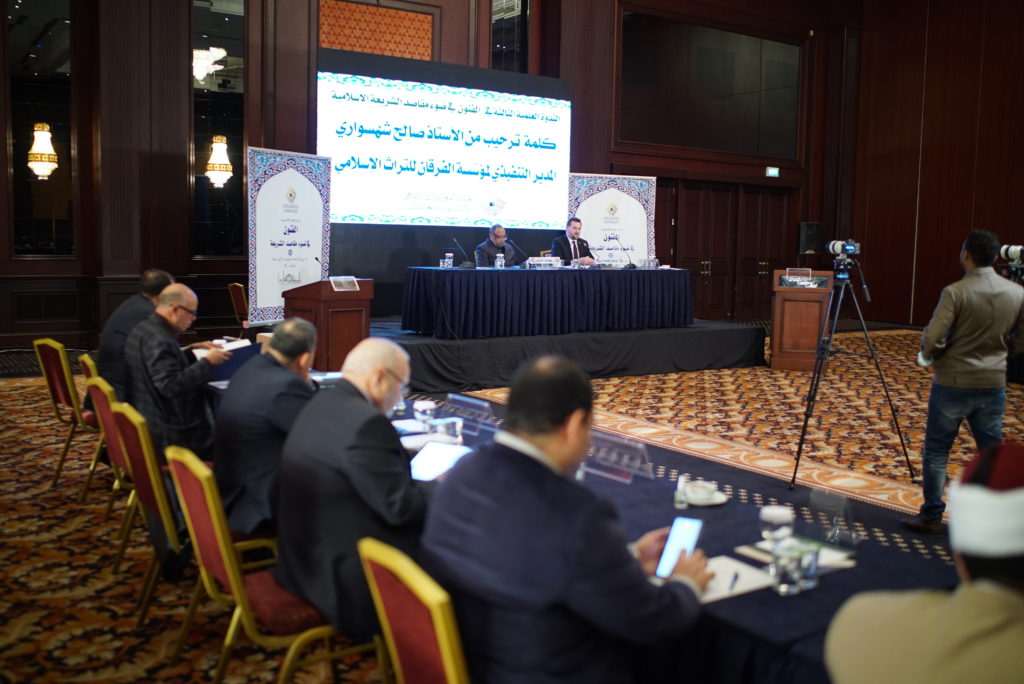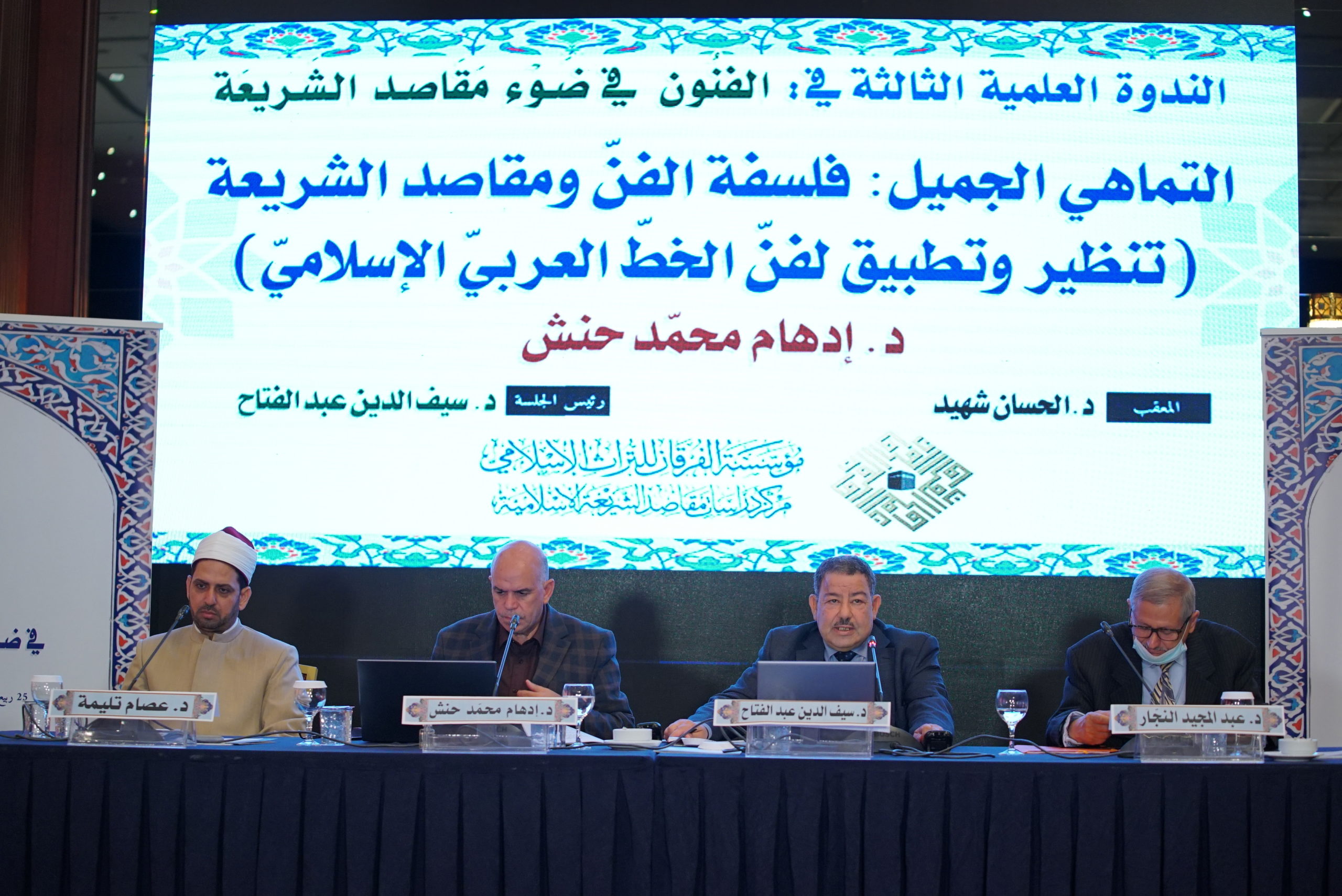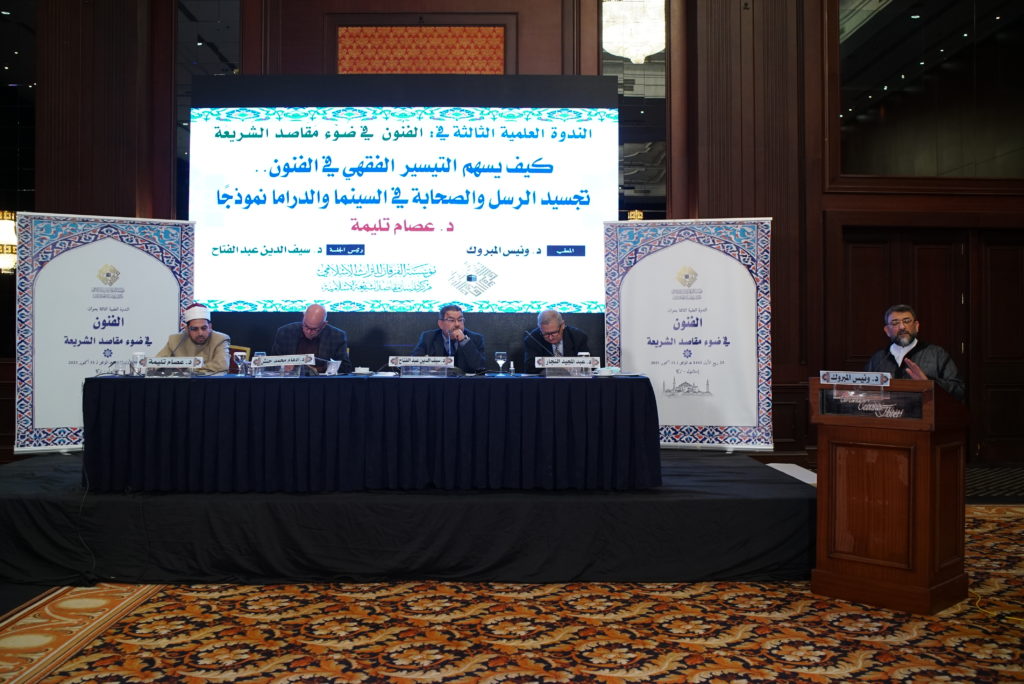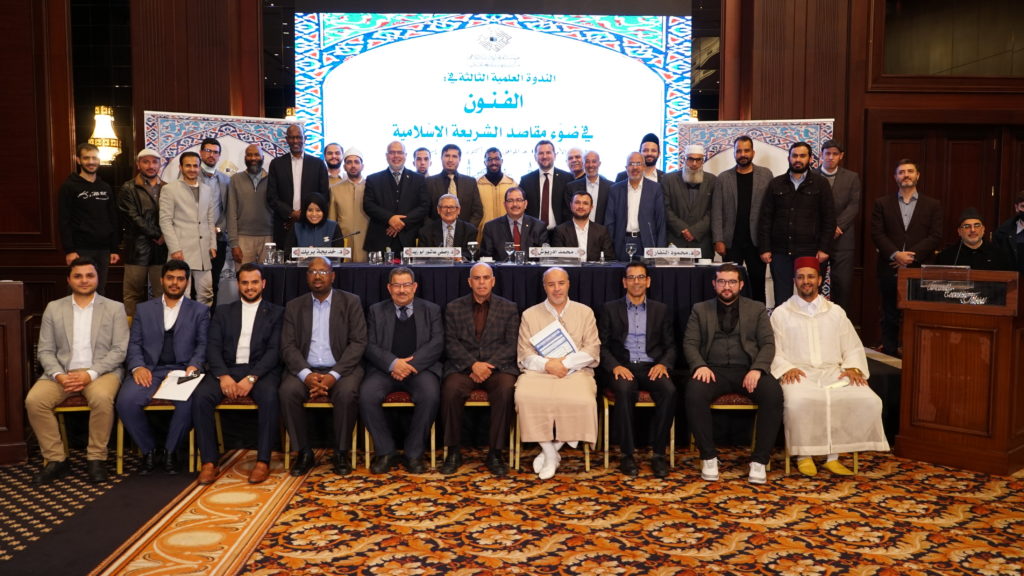The third symposium under the title “The Arts in Light of the Objectives of Islamic Law”
The third scientific symposium titled “The Arts in Light of the Objectives of Islamic Law” commenced with the aid and blessing of Allāh, the Almighty, on Sunday, 31 October 2021CE, in the welcoming setting of Grand Cevahir Hotel in Istanbul, Turkey.
The Opening Session chaired by Mr Sali Shahsivari
A recitation of enlightening verses from the Glorious Qurʾān marked the Symposium’s commencement. Mr Sali Shahsivari, Managing Director of Al-Furqān Islamic Heritage Foundation, then delivered a welcome speech focusing on the importance of the objectives (maqāṣid) of the arts, to be concluded here, following on from the two previous symposia. He added that the arts domain desperately needs to be framed based on the standard of objectives, and that the objectives serve the arts. Subsequently, Dr Issam al-Bashir delivered an opening lecture for the symposium titled “Renewal in the topic of art”. This focused on explaining the importance and motives of renewal, and that renewed rational consideration of art is intimately related to establishing civilisation and developing the human being. He postulated that the topic of art is in desperate need of renewal, rather than dependence on imitating juristic positions from the past.
Subsequently, a reception with hot beverages and light refreshments was then held in honour of guest and participant, scholars and researchers.

The First Session chaired by Dr Saifeldin Abdelfattah
Dr Idham Mohammed Hanash presented his paper titled “Beautiful blend: Art philosophy and Islamic law objectives, theorising and application to the art of Arabic Islamic calligraphy”. He introduced his paper by raising the problematic issue of the relationship between art philosophy and Islamic law objectives, considering this a kind of adventure, risky undertaking, and battle on epistemological and methodological fronts. He explained that this was due to the positive contemporary Islamic response to the question of art, continuing to be purely theoretical in its ephemeral religious interpretations of art. He defined, and then classified Islamic art disciplines into four kinds: (a) those disciplines acting as the foundation on which the framework of Islamic art is anchored, such as geometry (form), music (movement/rhythm), and visuals. (b) Formative disciplines establishing the nature of Islamic art, such as aesthetics and art philosophy, art elements, and arts criticism. (c) Disciplines grounding the identity and civilising nature of Islamic art, such as religious and cultural sciences, psychology, and sociology. (d) Disciplines helping refine Islamic art and elevate its aesthetic discourse, such as mathematics, physics, and chemistry. The lecturer also addressed the concept and epistemological nature of calligraphy, highlighting its aesthetic objectives.


Dr al-Hassan Shahid commented on the paper, considering Dr Idham Hanash’s paper as a specialised scientific work, in which the author had roamed the objectives-based and philosophical paths of calligraphy, granting it a dimension worthy of consideration and study in the Islamic discussion space, whether comparative, methodological, or complementary to other fields.
Yet, Dr Shahid did not hide his criticism of the paper, noting three fundamental issues:
First, the written discourse was overly complicated in explaining the philosophical wisdom of art by linking it to other fields, such as legal theory (uṣūl) and objectives.
Second, the specialised nature of terminology, where the paper included excessive linking between concepts from arts language with others from jurisprudence (fiqh) and philosophy.
Third, confusion in the areas of inquiry, in that these lack the consistency and order required of research purposes, along with a huge amount of information.
Notwithstanding, he highlighted the paper’s importance, and that it had tackled fine specialised questions and issues in art philosophy. Dr Shahid took issue with the author regarding the question of the objectives in calligraphy, how and why? Noting that this question revealed confusion in understanding the scientific or methodological relationship by which the author had linked what he called the aesthetic objectives with the Islamic law objectives, the Noble Qur’ān objectives, or values objectives; indeed, he had not articulated any methodological arrangement or epistemological correspondence between them. The researcher also addressed the general aesthetic objectives of the art of calligraphy; on this point, Dr al-Hassan aimed his criticism at the researcher on the matter of his novel classification of objectives into Divine (ḥaqāniyyah), aesthetic (jamāliyyah), and promoting good (khayriyyah), objectives. He rejected this thesis, especially when the researcher assigned the objectives related to religion to the aesthetic, rather than the Divine objectives.
Dr Shahid concluded his review by stating that the scientific paper will open promising horizons given its treatment of serious conundrums, in reconnecting the sciences with the arts, in their scientific, existential, and civilising objectives.
This was followed by Dr Abdul Majid al-Najjar’s paper titled “Purification of the human being as an objective of art”. In his paper, he focused on the aim of human existence being to civilise and develop Earth (‘imārat al-arḍ), emphasising that the human being’s self-purification in its different dimensions is a religious duty, if not in itself the aim of religious duty in general; indeed, each obligatory ritual act of religion is aimed at purification, which is the requisite for success; indeed, those who purify themselves, secure success.
The lecturer addressed the kinds of purification and their connection to art; such as purification of the soul, where the human being was created possessing a monotheistic innate nature (fiṭrah). However, he was also created with vain desires and vices that obscure this innate nature leading to heedlessness, and ending with denial, if he unrestrictedly pursued satisfaction of such desires and vices. Also purification of the intellect, because the human being will not settle on a proper methodology of knowledge without self-effort, where the human being is subjected to edification that stimulates these innate principles. Likewise, purification of the body, based on the general principle that the body represents a trust placed in human hands by Allāh, the Almighty. Dr Najjar then began to explain the role of art in purifying the human being, as religion’s purpose was to raise the human being to the highest levels of humanity in both individual and collective dimensions. Religion used the term ‘purification’ to express this uplift, and directed humans to the means by which to secure purification, making adopting these means a religious duty.
Dr Najjar highlighted that the intellect may appear to have no connection to art, where art is considered an expression of beauty and food for soul rather than mind. He explained this relationship quite clearly, and continued following the same approach in terms of the objective of art in purifying the body, and social purification that includes society in its entirety.
Dr Hudhaifa Akkash commented on Dr Najjar’s paper expressing his admiration, and, in his words, wholehearted alignment to it and the author. He considered the author one of those supporting and encouraging arts that adhere to Islam in the contemporary Islamic discourse, given the predominance of the “jurisprudence of frustration” in the words of some thinkers; a jurisprudence that virtually prohibits or restrict many of the permitted and wholesome things, due to a superficial, literalist understanding.
Dr Akkash made some observations on Dr Najjar’s paper, summarised as follows: questioning the paper’s title (Purification of the human being as an objective of art), in how will the author prove the claim that “the objective of arts is to purify the human being”? The farthest Islamic writings addressing the matter had ventured was to prove that Islam encourages responsible art, and allows clean art, and that it supports the expression of beauty according to Islamic rules. Our civilisation had patronised arts, such as religious song, muṣḥaf calligraphy and illumination, and vegetal and geometric decoration; moreover, our civilisation had rejected other arts conflicting with Islamic values and objectives. Yet, here the author was expanding the meaning and citing the beauty (and arts) in the Book and creatures of Allāh, and connects these to human arts.
Among other things, Dr Akkash broached the issue of the relationship between religion and art, and proceeded to explain this relationship, revealing the connection to Dr Najjar’s presentation.
This was followed by Dr Issam Talima’s paper, with the chosen title “personifying the Messengers and Prophets in cinema and drama”. He mentioned that the intent of his paper was not to address the jurisprudential aspect per se, even though such treatment, and whether it ended with prohibition, allowance, r further detail, is important scientifically. However, its importance lies in that the jurisprudential consideration of art as a means has become notably influential, as well as the role of the Islamic objectives in dealing with this means.
Dr Issam pointed out that the first political and religious decision prohibiting the personification of Prophets was during the time of Sultan Abdul Hameed II; likewise, in Egypt with the issue of a fatwa on the matter. This was followed by other fatwas and decisions banning and prohibiting this for several series drama productions. Dr Issam then proceeded to mention the evidencing used by those prohibiting the personification of Prophets. He concluded that the majority of fatwas issued on the matter were influenced by specific circumstances and guarded perspective on acting, its environment, and practitioners. He posited that these factors were based on emotion, and influenced by public sentiment, as well as being excessively strict. He attacked these fatwas concluding that there is strictness on the part of Sunni jurisprudents, and opined that this matter is allowed.
Dr Talima concluded his paper with the issue of examining the rules and conditions through which we must scrutinise those who may perform such roles. However, many of the scholars in the subsequent discussion did not accept what he said, and clarified with evidence the sanctity afforded to the Prophets, as they are the crème-de-la-crème of creation.
Dr Wanis al-Mabrook commented on the paper expressing his surprise at the issue of permitting the personification of Prophets by actors, which Dr Talima proposed. He emphasised the importance of preserving the sanctity of the Prophets, which is assured by religion and human society. Moreover, this sanctity may not be violated by acting given the influence it has on people. Dr Talima’s paper provoked intense discussion and raised significant problematic questions.
Second Session chaired by Dr Mohamed Drioueche
The session began with the paper by Dr Wasfi Ashour titled “Revolutionising the arts: a reading into practical examples, and tracing the objectives’ influences”. He structured his paper around an introduction and four areas of inquiry. In the introduction, he addressed the relationship of the arts to the senses, where each sense from hearing, sight and others is related to the arts. He dedicated the first area of inquiry to the linguistic arts and their influence on the Islamic law objectives, in poetry, literary texts, histories, biographies, calligraphy, and others; all of which, possess their beauty, and aesthetic and artistic concepts.
In the second area of inquiry, he addressed the auditory arts and their influence on the Islamic law objectives; given that they encompass everything that influences hearing and is captured by the ear, such as music, song, Qur’ān recitation; the latter counting as an art in its own right. Dr Wasfi mentioned that what distinguishes auditory arts among the Arabs was their constant congruent connection with life’s actions. Indeed, music, song, camel-driver’s song (ḥidā’), amatory prelude (naṣīb), chant (nashīd), call to prayer (adhān), recitation (tartīl), and other auditory art forms were a feature of daily life for the Muslim.
The third area of inquiry focused on presenting the visual arts and their influence on the Islamic law objectives. Dr Wasfi opined that these kinds of arts are considered one of the most important tributaries channelling faith into hearts. The human being through reflection on Allāh’s creation, the heavens, earth, creatures, and the horizons, which are all “visuals” is led to believe in Allāh, and acquires reinforced faith in Allāh’s insuperable power, and force, as well as beauty and majesty, through the beauty and novelty of His creation.
The fourth area of enquiry addressed the audio-visual arts and their influence on the Islamic law objectives. Following an explanation of the intent, Dr Wasfi mentioned that education is the most important domain where audio-visuals are used. These represent an additional means complementing the educational process and enriching presented information. In this form, it contributes in a limited way to improving education. The lecturer also pointed out that he had presented practical examples and quite important comments for each area of inquiry.
This was followed by Dr Mahmoud al-Naffar’s paper titled “Cinematic necessities from the perspective of Islamic law objectives: inventing persons and events as an example”. He structured his paper on artistic and jurisprudential introductions, where he examined the issue of falsehood/lying and its forms in light of legal theory-, and objectives-based rational consideration. He proceeded to outline the purposes of the paper: the first considering the cinematic craft in light of objectives-based consideration; the second, inventing fictional characters, and attributing events to them in the cinematic work, from the objectives-based perspective; the third, inventing fictional events in cinematic work, and attributing these two real persons, from the perspective of Islamic law objectives. He concluded that the blanket approach to prohibition of lies without framing it in the objectives-based consideration, was one of the key reasons behind the appearance of fatwas ruling prohibition and restriction in the cinematic art work. Moreover, representing real persons, and attributing events to them take the form of lying, and therefore contemporary jurists have differed on the matter; some classified these as invention of characters, considering that the viewer knows that the content presented is different to reality, while others considered these lies from the perspective of form and reality, and are further divided into those prohibiting and others allowing.
Subsequently, Dr Khadija Brik addressed the “Cinematic presentation of the Noble Qur’ān stories in world cinema, between misrepresentation and the need for ideal utilisation: an analytical study of the film, Noah”. The lecturer emphasised that huge budgets are allocated to such types of artistic works. Yet, sadly these tended to distort and misrepresent. She explained the importance of cinema and its role in serving the Noble Qur’ān, where cinema found suitable and rich content in the Qur’ānic stories from which to produce world works. She employed many questions about the film, Noah, as an important entry to its examination. She opened with the following questions:
- What are the implicit semantics and dimensions conveyed by the cinematic image employed in US world cinema works that treated the story of Prophet Noah, peace be upon him.
- What are the topics addressed by the US film, Noah, connected to the story of Prophet Noah, peace be upon him?
- Did the themes treated in the US film, Noah, reflect the religious narrative of the Holy Bible and the Noble Qur’ān?
Subsequently, she examined those studies that addressed the image of Muslims in cinema, mentioning among others:
- “Muslim image in American cinema”, a semiologic analysis of both films, “Traitor” and “The Kingdom”.
- “Reel Bad Arabs: How Hollywood Vilifies a People”. Jack Shaheen worked through this study to analyse over 1000 films, starting from the early days of silent American cinema to latest releases. He stated that according to his analysis Arabs and Muslims were always representing evil, enemies, and barbaric.
- The 2014CE study titled “The image of Islamic activists on screen” by Ahmad Salim. This study aimed to explore the cinematic image and how it is employed to serve politicised ideology, particularly how Islamic activists are depicted on Western screens and in the Western world.
- “The image of Islam in Western media” by Mohamed Bashari (2004CE). The book’s importance derives from its presentation of examples of some distorted images of Islam and Muslims in French, German, and British media.
She also covered the objectives, purposes, and topics of the story in the Noble Qur’ān. She did not neglect to explain cinema’s importance and role in serving the Noble Qur’ān, considering that the Islamic film is a successful tool for promulgating Islam. She then traced the chronology of cinematic presentation of the Noble Qur’ān’s stories in world cinema, and the aspects of misrepresentation. Subsequently, she alluded to stories from the Holy Bible, such as the story of Jesus in cinema.
The researcher focused on analysing the film, “Noah”, using tools and technologies, which she presented as follows:
Descriptive tools, including technical cutting, sequencing, and describing the film’s images.
Technical cut is a term indicating describing the film, Noah, in its final form, and revolves around the following:
- The shot comprising shot number, shot sequence, camera angle, and camera movements.
- Soundtrack comprising music, sound and dialogue, and sound effects.
- Frame track comprising frame content, characters, setting, and objects.
- Editing, this technology represents the process of defining sequences.
- Description of the film’s frames, meaning converting the media messages and meanings contained by the film into written language; this technology provides details related to frame content, comprising the technology of freezing the frame.
This study concluded that there was deliberate misrepresentation of Prophet Noah, peace be upon him, compared to the religious account. The film portrayed the eternal struggle between good and evil, and between mercy and forgiveness, basing that on the historical context. She closed her paper with an important recommendation, which is confessing to the clear shortcoming of Islamic media discourse generally, and Islamic cinematic discourse, especially. This compels the Islamic world to open up to the Western world and the realities of the time, while preserving the Muslim nation’s fundamentals and customs. Moreover, Muslims in the West should form a lobbying force, raising their voice to defend their religion, image, and identity.
Dr Yousef Fathi Hamdan commented on her paper, emphasising that the paper is novel and important. It addressed a vital issue relating to the relationship between the religious and cinematic. Furthermore, it was a bold study in its area with many positives. However, he restricted himself to elucidating some key aspects, such as his discussion of quotes and references, which was typically not defined by the researcher. He then touched upon an important issue, which is the relationship of the term, Islamic art and Islamic cinema, indicated by researcher, Khdija Brik. However, he commented that the paper focused on desired effects and results on the audience, without providing a scientific description or defining these according to clear rules, as is customary in the techniques of defining terms. The researcher opined that this is further complicated when compared with what the West possesses.
Dr Hamdan posited that cinema and cinematic film, as addressed by the researcher require further expansion and greater precision, given that cinema is part of the cultural industry, with its own economic lifecycle differing from other industries. He also addressed the matter of the story in the Qur’ān, and its connection to the literary and artistic aspect, regardless of artistic terms tied to cinema and culture. Similarly, considering cinema a proselytising tool. He ended his commentary by exploring the issue of prohibiting personifying the Prophets by actors, saying that this is an old-new matter, as articulated in Abdullah Ibn al-Siddiq’s book, “Iqāmat al-dalīl ‘alā ḥurmat al-tamthīl (Establishing indicants on the prohibition of acting)”, and posited that it required a new approach.
The participants then began to discuss the papers, expressing their view on their importance and depth, while raising a multitude of scientific, epistemological, and artistic issues, which would aid in scholarly research. They also praised the efforts expended by Al-Furqān Foundation and its partners in driving forward scientific research, and identifying all that is novel and beneficial.
Dr Mohamed Drioueche closed the session by thanking all those present, whether scholars, participants, or organisers. Dr Moulay Hasan al-Barhoumi then recited verses from the Glorious Qur’ān.




